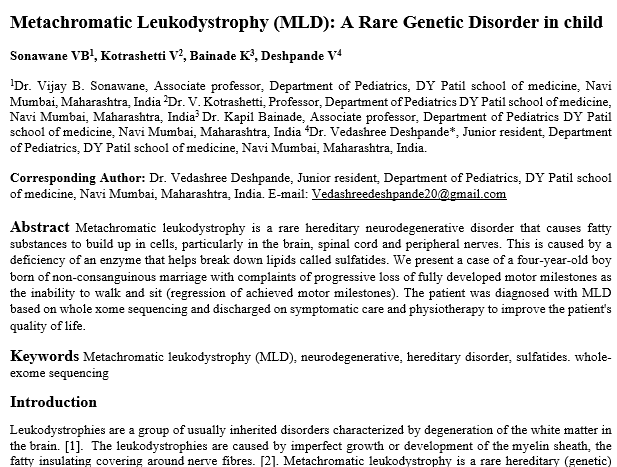Metachromatic Leukodystrophy (MLD): A Rare Genetic Disorder in child
Abstract
Metachromatic leukodystrophy is a rare hereditary neurodegenerative disorder that causes fatty substances to build up in cells, particularly in the brain, spinal cord and peripheral nerves. This is caused by a deficiency of an enzyme that helps break down lipids called sulfatides. We present a case of a four-year-old boy born of non-consanguinous marriage with complaints of progressive loss of fully developed motor milestones as the inability to walk and sit (regression of achieved motor milestones). The patient was diagnosed with MLD based on whole xome sequencing and discharged on symptomatic care and physiotherapy to improve the patient's quality of life.
Downloads
References
Walterfang M, Mocellin R, Copolov D, Velakoulis D. Secondary hallucinations. In Sachdev PS, Keshavan MS, editors, Secondary Schizophrenia. Cambridge, UK: Cambridge University Press. 2010. p. 21 – 43.
Vaibhav S. Lokhande, Anil Gaur. A Case of Infantile Metachromatic Leukodystrophy. J Neurol Res. 4(5-6), 2014, 138-140. doi: http://dx.doi.org/10.14740/jnr294e.
Mallikarjun K, Deepak P Bhayya, Deepesh Singh, Tarulatha R Shyagali. Metachromatic Leukodystrophy: A Rare Case Report. Journal of Academy of Advanced Dental Research, Vol 2; Issue 3, September 2011. DOI:10.1177/0883073814542948.
Gopen Kumar Kundu, Saheen Akhter, M Mizanur Rahman. Metachromatic Leukodystrophy: A Case Report. BSMMU J. 9(1), 2016, 62-65. : http://dx.doi.org/10.47583/ijpsrr.2020.v65i02.018

Copyright (c) 2021 Author (s). Published by Siddharth Health Research and Social Welfare Society

This work is licensed under a Creative Commons Attribution 4.0 International License.


 OAI - Open Archives Initiative
OAI - Open Archives Initiative


